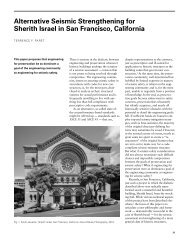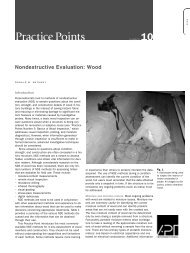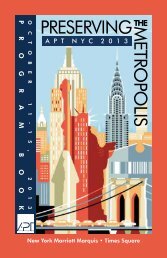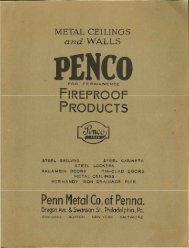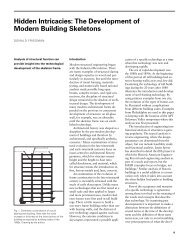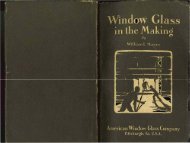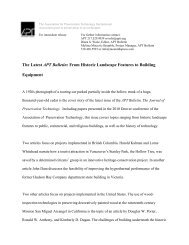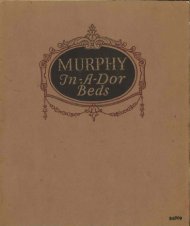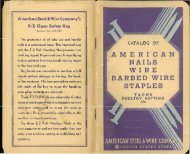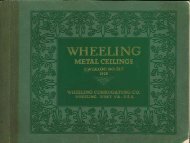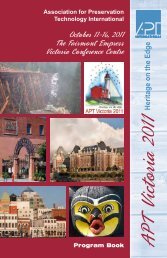Basics of Wood Inspection: Considerations for Historic Preservation
Basics of Wood Inspection: Considerations for Historic Preservation
Basics of Wood Inspection: Considerations for Historic Preservation
Create successful ePaper yourself
Turn your PDF publications into a flip-book with our unique Google optimized e-Paper software.
Fig. 6.Decayed beam supportinga timber column.Fig. 7.Insect damage on a porchbeam, as evidenced by theyellow frass from powderpost beetles.Fig. 8.Awl inserted to probe theinterface between a timberbeam and a masonry wall.the knowledge <strong>of</strong> how grades are established within thedesign codes.Tools <strong>for</strong> Basic <strong>Wood</strong> <strong>Inspection</strong>There are three “tools” <strong>for</strong> a basic wood inspection:visual inspection, a sharp probe, and a moisture meter.Equipment used <strong>for</strong> nondestructive evaluation can givemuch more in<strong>for</strong>mation about wood condition, but theuse <strong>of</strong> such tools should be reserved <strong>for</strong> situationswhere a basic inspection cannot sufficiently answer thequestions <strong>of</strong> the architect, engineer, or owner. An individualexperienced in wood inspection may also use ahammer <strong>for</strong> sounding or a portable hand drill to gainin<strong>for</strong>mation about the relative condition <strong>of</strong> the wood,although neither <strong>of</strong> these methods allows <strong>for</strong> quantifyingthe extent <strong>of</strong> deterioration: they are best suited <strong>for</strong>identifying locations that warrant further investigation.A sharp probe will also not allow <strong>for</strong> quantifying theextent <strong>of</strong> deterioration in larger members, but it easilydetects areas <strong>of</strong> surface deterioration and should beincluded in any wood-inspection tool kit.A visual inspection allows <strong>for</strong> identifying componentsthat are missing, broken, or in an advanced state <strong>of</strong>deterioration. Missing components are those that havebeen removed or have fallen away, frequently due toextensive deterioration. If missing components wereintended to provide structural support or protectionfrom the elements (e.g., to prevent moisture intrusion),their replacement may be essential to prevent long-termdamage to the structure. This problem <strong>of</strong>ten manifestsas ro<strong>of</strong> leaks in historic buildings. A small mirror with atelescoping handle and a flashlight are useful wheninspecting relatively inaccessible areas.Visual inspection also allows <strong>for</strong> the detection <strong>of</strong>past or current moisture problems as evidenced bymoisture stains on the exposed surface <strong>of</strong> the wood.Further, visual inspection enables detection <strong>of</strong> externalwood-decay fungi or insect activity as determined by thepresence <strong>of</strong> decay fruiting bodies, fungal growth, insectbore holes, mud tubes, or wood removed by wooddestroyinginsects. Visual inspection provides a rapidmeans <strong>of</strong> identifying areas that may need further investigation.Probing the wood with a sharp pick or an awl enablesrapid detection <strong>of</strong> voids in the wood that may not bevisible on the surface. Internal decay is <strong>of</strong>ten maskedby the lack <strong>of</strong> evidence on the exposed surface <strong>of</strong> thewood. For advanced decay where large internal voidsare present near the surface, probing can detect evidence<strong>of</strong> potentially serious deterioration. For internalvoids in large timbers more advanced inspection methodsare generally required to detect the void. Even <strong>for</strong>the early stage <strong>of</strong> decay, probing can reveal areas thathave experienced sufficient deterioration due to decayfungi by allowing <strong>for</strong> easy entry <strong>of</strong> a sharp probe, althoughno void is yet present. <strong>Wood</strong> without incipientdecay tends to <strong>of</strong>fer more resistance to probing, due toits higher density and more intact internal wood structure(Fig. 8).The true moisture content <strong>of</strong> wood can be determinedonly by oven drying a sample removed from astructure. However, portable moisture meters usingelectrical capacitance or electrical conductance can displaythe approximate moisture content <strong>of</strong> wood.Capacitance-type meters measure the electrical fieldwithin a small area <strong>of</strong> a piece <strong>of</strong> wood (Fig. 9). They donot require penetration <strong>of</strong> probes into the wood andgenerally provide the average moisture content throughouta certain depth, typically less than an inch; however,a wet surface (e.g., rain on a window sill) can dramaticallyaffect the reading. These meters are particularlyuseful <strong>for</strong> measuring the moisture content <strong>of</strong> interiorand exterior woodwork (doors, windows, trim, etc.) anddimension lumber.For thicker material, such as structural timber, a conductancemeter, <strong>of</strong>ten called a resistance moisture4 PRACTICE POINTS 03



